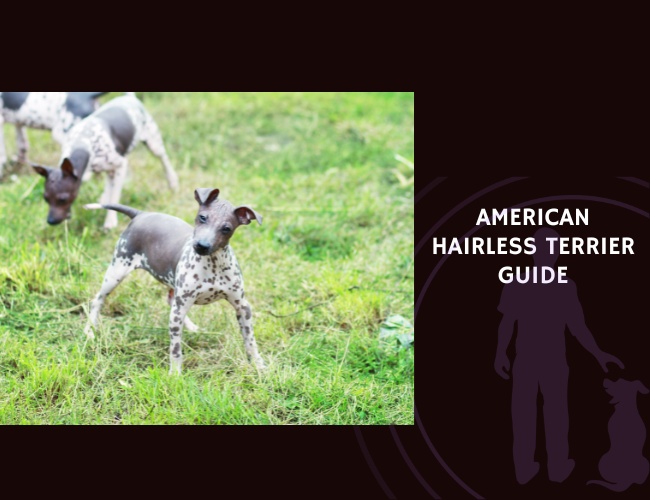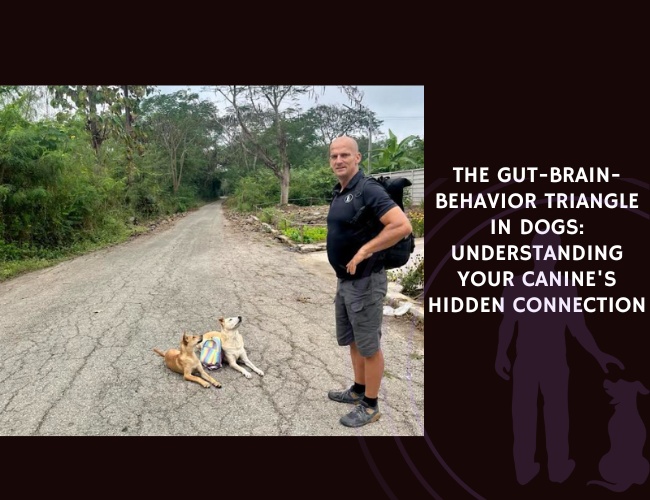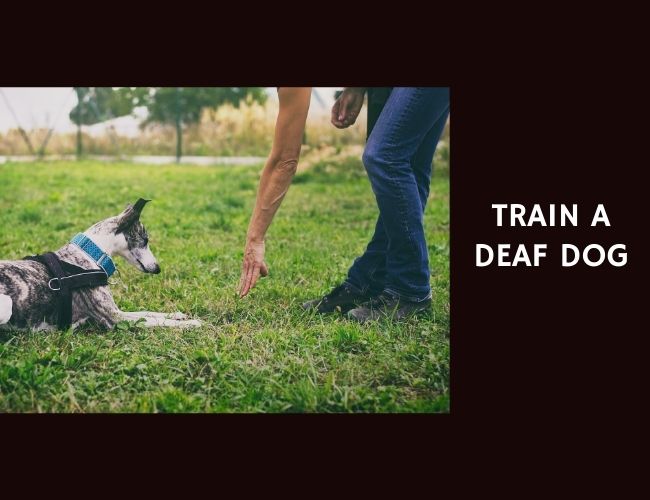Introduction
Picture a terrier with all the spunk, intelligence, and loyalty you’d expect—but without a single strand of fur. The American Hairless Terrier’s story began with a single extraordinary puppy named Josephine, born completely hairless in Louisiana in 1972. From this remarkable genetic surprise emerged an entirely new breed that challenges everything we thought we knew about terriers.
Today’s American Hairless Terrier offers something truly special: all the feisty terrier personality wrapped in a hypoallergenic, uniquely beautiful package. Whether you’re drawn to their distinctive appearance or seeking a spirited companion who won’t trigger allergies, let us guide you through everything you need to know about these remarkable dogs. You might notice that beneath their bare skin beats the heart of a true terrier—playful, intelligent, and utterly devoted to their families. 🐾
Character & Behavior: Understanding Your Hairless Wonder
The Journey from Ratters to Companions
Did you know that your American Hairless Terrier’s ancestors were champion rat catchers? This breed’s transformation from working terrier to beloved companion tells a fascinating story of purposeful breeding. When Josephine appeared in that Rat Terrier litter, breeders Willie and Edwin Scott recognized an opportunity to create something special—a terrier who could bring joy without triggering allergies.
The terrier spirit remains strong, manifesting in behaviors you’ll recognize daily. Your AHT hasn’t forgotten those vermin-hunting roots, which means they’ll enthusiastically chase anything small that moves. This isn’t a behavior flaw—it’s their heritage speaking through generations of selective breeding. Understanding this helps you appreciate why your furry friend (well, not-so-furry friend!) gets so excited when they spot a squirrel.
Modern breeding has softened some edges while preserving the best terrier traits. Unlike their more independent cousins, American Hairless Terriers are known for being exceptionally affectionate—sometimes fawningly so. They’ve retained the intelligence and alertness of working terriers but channeled it into being attentive, trainable companions who want nothing more than to be part of your daily life.
Temperament That Sets Them Apart
Your American Hairless Terrier brings a unique blend of characteristics that might surprise you. They’re remarkably good with children—unusual for terriers—making them excellent family dogs when properly socialized. This gentle nature with kids doesn’t mean they’re pushovers; they simply understand the difference between play and protection.
The affection level is off the charts with these dogs. They form intense bonds with their families and thrive on physical closeness. You might find your AHT attempting to burrow under blankets with you or following you from room to room. This isn’t clingy behavior—it’s their way of maintaining that trusting relationship they crave.
Social dynamics with other pets require careful consideration. Your AHT will generally get along wonderfully with dogs their size or larger. Cats? That depends on early exposure and individual personality. But here’s where their terrier nature shows: hamsters, guinea pigs, or pet birds will trigger that prey drive instantly. No amount of training can completely override centuries of breeding for vermin control.
Intelligence and Problem-Solving
The cognitive abilities of your American Hairless Terrier place them among the brightest of the terrier breeds. They learn quickly and retain information well, which makes training both rewarding and sometimes challenging. Why challenging? Because smart dogs figure out shortcuts and test boundaries—it’s how their minds work.
Problem-solving comes naturally to these dogs. You might notice your AHT figuring out how to open doors, reach forbidden treats, or create their own games when bored. This intelligence needs channeling through mental stimulation, or it turns into mischief. Think of it like having a gifted child—they need enrichment to thrive.
Adaptability shines through in novel situations. Unlike some terriers who can be rigid in their thinking, American Hairless Terriers adjust well to new environments and routines. This cognitive flexibility makes them excellent candidates for various dog sports and activities beyond basic obedience.
Vocalization & Communication: How Your AHT “Talks”
Understanding Their Unique Language
Your American Hairless Terrier has a fascinating way of communicating that goes beyond typical dog behavior. They literally sweat when stressed or overheated—the only dog breed that does this! This visible stress indicator gives you immediate feedback about their emotional state, something other dog owners can only guess at through behavior.
Alert barking serves a purpose in their communication repertoire. They’re not excessive barkers by nature, but they will announce visitors, unusual sounds, or anything they deem noteworthy. This watchdog tendency comes from their terrier heritage, where alerting to intruders protected grain stores from vermin. Today, it means you’ll always know when the Amazon driver arrives!
Body language speaks volumes with these expressive dogs. Without fur to raise or flatten, they communicate through:
- Ear positioning (forward for interest, back for uncertainty)
- Tail carriage and movement patterns
- Full-body wiggling when excited
- Distinctive “terrier trembles” when intensely focused
Emotional Expression and Needs
The emotional transparency of your American Hairless Terrier creates a unique bond. Separation anxiety can develop quickly if not addressed early. These dogs form such strong attachments that being alone feels genuinely distressing to them. This isn’t manipulation—it’s genuine emotional need.
Joy expression is unmistakable in these dogs. A happy AHT practically vibrates with enthusiasm, often accompanied by what owners call the “hairless dance”—a full-body wiggle that starts at the nose and ends at the tail tip. You’ll notice this greeting ritual becomes more elaborate for favorite people.
Stress signals require attention because of their sensitive nature. Beyond the unique sweating response, watch for:
- Excessive licking or scratching (even without skin issues)
- Destructive behaviors when anxious
- Clingy behavior escalating beyond normal
- Changes in appetite or sleep patterns
Understanding these communication patterns helps you respond appropriately to your dog’s needs, strengthening that special bond. 🧡
Training & Education: Shaping Your Brilliant Companion
Early Socialization Strategies
The critical window between 3-14 weeks shapes your American Hairless Terrier’s entire future. Start socialization immediately upon bringing your puppy home. Every positive experience during this period creates neural pathways that influence adult behavior. You’re literally building your dog’s emotional blueprint for life.
Exposure needs to be systematic, not overwhelming. Your AHT puppy should meet:
- People of all ages, appearances, and energy levels
- Other dogs (vaccinated and calm initially)
- Various environments (urban sounds, different surfaces, weather)
- Handling exercises (preparing for grooming and vet visits)
Remember, your hairless puppy is more vulnerable than coated breeds—protect their skin while exposing them to the world.
The terrier confidence needs nurturing. While naturally bold, American Hairless Terriers can develop anxieties without proper socialization. Each positive interaction builds resilience. Think of it as emotional vaccination—small, controlled exposures create immunity to fear.
Managing Terrier Independence
Your American Hairless Terrier’s trainability ranks among the best of all terriers, but don’t mistake this for automatic compliance. They have opinions and aren’t shy about sharing them. This isn’t defiance—it’s the independent thinking that made their ancestors successful ratters.
Leadership must be consistent but kind. These dogs will test boundaries not from dominance but from intelligence. They’re asking, “Are you sure about this rule? What if I do it slightly differently?” Your response shapes whether you have a partner or a problem.
Training strategies that work:
- Keep sessions short (5-10 minutes) but frequent
- Vary the exercises to prevent boredom
- Use high-value rewards (not just kibble)
- End on success, even if it means simplifying the task
- Practice in different locations once basics are mastered
The stubborn streak you might encounter isn’t personal—it’s genetic programming meeting modern expectations.
Impulse Control and Focus
That prey drive we mentioned? It needs management from day one. Your AHT can go from calm to chase mode in milliseconds when triggered. This isn’t disobedience—it’s instinct overriding training in that split second.
Emergency recall training is non-negotiable. Practice this command more than any other:
- Start indoors with no distractions
- Graduate to enclosed outdoor spaces
- Add controlled distractions gradually
- Reward lavishly for compliance
- Never use recall for negative experiences (like bath time)
Impulse control exercises should be daily practice:
- “Wait” at doorways and before meals
- “Leave it” with increasing temptations
- “Stay” with duration, distance, and distractions
- “Look at me” to break fixation on triggers
These aren’t just commands—they’re life skills that keep your terrier safe in a world full of temptations.
Performance & Activities: Channeling That Terrier Energy
Exercise Requirements and Options
Your American Hairless Terrier needs at least 30-45 minutes of active exercise daily, but here’s the thing—quality matters more than quantity. A tired terrier is a good terrier, but an exhausted one might just be cranky. Finding the sweet spot takes observation and adjustment.
Physical exercise alone won’t suffice. These intelligent dogs need mental challenges woven into physical activity:
- Agility courses (even homemade ones)
- Scent work games
- Interactive fetch with commands
- Hide-and-seek with family members
- Puzzle walks (letting them investigate safely)
Without proper outlets, behavioral problems emerge quickly. That excessive barking you’re hearing? That’s pent-up energy seeking release. The destroyed cushion? Boredom manifesting as creativity. These aren’t character flaws—they’re communication about unmet needs.
Sports and Specialized Activities
The American Hairless Terrier excels in organized activities that challenge both body and mind. Agility competitions showcase their natural athleticism while providing structured exercise. You’ll be amazed at how quickly they master complex courses—their terrier determination combined with eagerness to please creates a winning combination.
Rally obedience suits their personality perfectly. Unlike traditional obedience, rally encourages enthusiasm and allows for that terrier sparkle to shine through. Your AHT gets to work closely with you while navigating courses that change each time—perfect for preventing boredom.
Scent work taps into ancient instincts. Remember those ratter ancestors? They used their noses to locate prey in dark barns and grain stores. Modern scent work gives your AHT a job that satisfies deep genetic drives while being completely safe and controlled.
Mental Stimulation Needs
Brain games aren’t optional extras—they’re essential for your AHT’s wellbeing. These dogs think constantly, and without appropriate outlets, they’ll create their own entertainment (usually at your furniture’s expense).
Daily mental challenges might include:
- Food puzzles and slow feeders
- Training new tricks (they can learn dozens!)
- Interactive toys that dispense treats
- “Find it” games around the house
- Rotating toy selection to maintain novelty
The beauty of mental stimulation? It tires them out faster than physical exercise alone. A 15-minute training session can be more exhausting than a 30-minute walk.
Playful. Loyal. Unique.
Born from a surprise. Emerging from one hairless pup in 1972, the American Hairless Terrier evolved into a hypoallergenic breed that keeps the full terrier heart without the coat.
Heritage fuels instinct. Once fierce ratters, they still chase with enthusiasm, carrying forward generations of hunting drive while offering unmatched affection as modern companions.
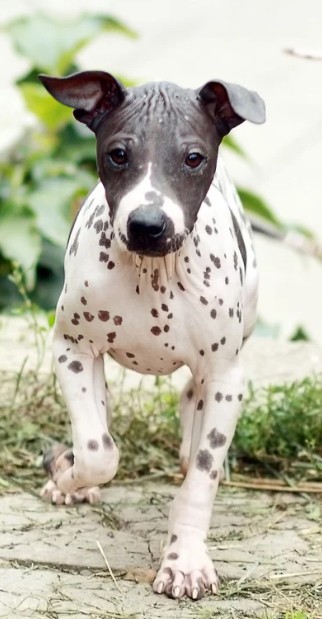
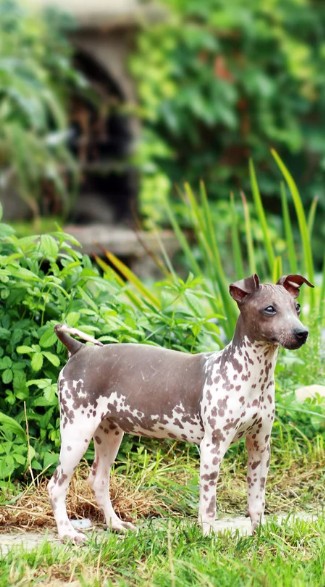
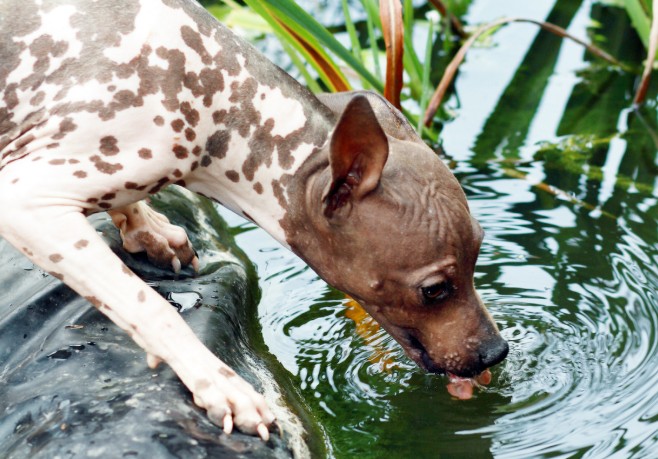
Affection defines their bond. Exceptionally close to family and gentle with children, they thrive on togetherness, blending terrier spirit with warmth, trust, and playful devotion.
Nutritional Recommendations: Fueling Your Unique Friend
Dietary Foundations
Your American Hairless Terrier’s nutritional needs reflect both their terrier heritage and unique physiology. Adult dogs thrive on food with about 18% protein and 5% fat, while puppies need approximately 22% protein and 8% fat for proper development. These aren’t arbitrary numbers—they’re based on AAFCO standards adjusted for breed-specific needs.
Portion control prevents problems. Feed adults half a cup to one cup of high-quality food daily, split between two meals. This might seem modest, but remember—these are small, efficient dogs. Overfeeding leads to obesity, which stresses joints and organs already working hard to maintain that unique physiology.
Puppy feeding requires special attention:
- Five small meals daily initially
- Approximately 900 calories per day
- Gradual transition to adult schedule by 12 months
- Never free-feed (leave food out constantly)
- Monitor growth rate carefully
The temptation to spoil these affectionate dogs with treats is strong, but maintaining ideal weight is crucial for longevity.
Skin Health Through Nutrition
Without a protective coat, your AHT’s skin needs nutritional support from within. Omega-3 fatty acids are non-negotiable—they maintain skin integrity, reduce inflammation, and support healing. Think of them as internal moisturizer for that exposed skin.
Key nutrients for skin health:
- Fish oil supplements (consult your vet for dosing)
- Vitamin E for antioxidant protection
- Adequate protein for cell regeneration
- Zinc for wound healing and barrier function
- Biotin for overall skin health
Some owners report excellent results with raw feeding diets, noting improvements in skin condition and reduced irritation. If you’re considering this route, work with a veterinary nutritionist to ensure balance.
Food allergies can masquerade as skin issues. Common culprits include:
- Beef and dairy (most frequent offenders)
- Chicken and eggs
- Wheat and soy
- Fish (ironically, despite omega-3 benefits)
If your AHT develops skin issues, an elimination diet might reveal dietary triggers.
Life Stage Nutritional Adjustments
Your American Hairless Terrier’s nutritional needs evolve throughout their life. Puppyhood demands building blocks—higher protein and fat support rapid growth and brain development. This isn’t the time to economize on food quality.
Adult maintenance (1-8 years) focuses on sustaining ideal condition:
- Consistent high-quality protein (18% minimum)
- Moderate fat to maintain energy without weight gain
- Adjustment based on activity level
- Seasonal modifications (more calories in winter)
Senior nutrition (8+ years) requires thoughtful adjustment:
- Protein needs might increase (contrary to old beliefs)
- Joint support supplements become valuable
- Smaller, more frequent meals aid digestion
- Enhanced omega-3s support cognitive function
- Regular weight monitoring prevents obesity
Remember, these dogs can live 14-16 years with proper care—nutrition plays a huge role in quality of life during those senior years. 🧠
Health Concerns: Protecting Your Hairless Companion
Unique Dermatological Considerations
The absence of fur creates vulnerabilities you must actively manage. Sun protection isn’t optional—it’s essential. Your AHT needs SPF 30 sunscreen applied 15-30 minutes before sun exposure, reapplied after swimming or heavy activity. This isn’t overcautious—it’s preventing painful burns and potential skin cancer.
Skin care routine basics:
- Daily inspection for cuts, scrapes, or irritation
- Regular bathing (weekly or biweekly)
- Moisturizing as needed (avoid human products)
- Protective clothing during peak sun hours
- Climate-appropriate protection year-round
Interestingly, despite their exposed skin, American Hairless Terriers are less prone to skin conditions than other hairless breeds. The recessive nature of their hairless gene provides unexpected protection against many dermatological disorders.
Acne and bacterial infections can occur, particularly in adolescent dogs. These aren’t hygiene failures—they’re normal challenges of having exposed skin. Regular gentle cleansing and avoiding comedogenic products helps prevent issues.
Genetic and Hereditary Conditions
Understanding your AHT’s genetic vulnerabilities helps you provide preventive care. The SGK3 gene mutation that causes hairlessness is well-understood and doesn’t carry the dental abnormalities seen in other hairless breeds. Your AHT has normal dentition—a significant health advantage.
Orthopaedic concerns to monitor:
- Patellar luxation (kneecap dislocation)
- Hip dysplasia (less common but possible)
- Legg-Calvé-Perthes Disease (hip joint degeneration)
These aren’t inevitable—many dogs never experience orthopaedic issues. Weight management and appropriate exercise reduce risks significantly.
Genetic testing reveals hidden risks:
- Degenerative Myelopathy (DM)
- Primary Lens Luxation (PLL)
- Progressive Retinal Atrophy (PRA)
Responsible breeders test for these conditions. If you’re adopting, consider testing to prepare for potential future needs.
Preventive Health Strategies
Periodontal disease affects 80-90% of dogs over age three, worse in smaller breeds like your AHT. Dental care must start early:
- Daily brushing (ideal but often impractical)
- Dental chews and appropriate toys
- Regular professional cleanings
- Monitor for signs of dental pain
Regular health screening catches problems early:
- Biannual vet visits after age 8
- Annual blood work to establish baselines
- Regular weight checks (obesity creeps up slowly)
- Skin examinations by professionals
- Eye and ear checks during routine visits
The 14-16 year average lifespan is achievable with vigilant care. Many American Hairless Terriers remain active and playful well into their senior years when health needs are met proactively.
Lifestyle & Environment: Creating the Perfect Home
Climate Management Essentials
Your hairless friend requires year-round climate consideration. Winter isn’t just uncomfortable—it’s potentially dangerous without proper protection. That sweater isn’t a fashion statement; it’s necessary equipment. Indoor temperature regulation becomes part of your daily routine.
Cold weather management:
- Multiple sweaters/coats for rotation
- Booties for snow and ice
- Shortened outdoor sessions
- Warm bedding options
- Draft-free sleeping areas
Summer challenges are equally serious. Without fur for UV protection and temperature regulation, your AHT depends on you for safety:
- Limited midday outdoor exposure
- Protective clothing or sunscreen always
- Access to shade and water
- Never leave in vehicles (they overheat faster)
- Monitor for heat stress (remember, they sweat!)
Creating comfortable indoor environments means maintaining moderate temperatures year-round—your heating and cooling bills might increase, but your companion’s comfort is worth it.
Housing and Space Adaptations
The American Hairless Terrier’s adaptability surprises many owners. Apartment living works beautifully when exercise needs are met. These aren’t dogs who need acres to roam—they need engagement and activity, which can happen anywhere.
Urban adaptations for success:
- Establish routine walking routes
- Find safe off-leash areas (if possible)
- Create indoor exercise options
- Provide mental stimulation to compensate for space
- Build strong recall for safety
Suburban and rural settings offer different opportunities:
- Secure fencing is essential (they will chase)
- Designated digging areas satisfy instincts
- Protection from predators (hawks see small dogs as prey)
- Regular tick checks despite no fur
- Snake awareness in appropriate regions
Your AHT doesn’t care about square footage—they care about being with you and having their needs met.
Family Integration Dynamics
These dogs thrive in family settings when properly integrated. Children and AHTs can be magical together, but success requires preparation. Unlike many terriers, American Hairless Terriers show remarkable patience with kids, but they’re not indestructible toys.
Age-appropriate interactions matter:
- Toddlers need constant supervision
- School-age children can participate in training
- Teenagers might enjoy agility or sports together
- Teach children about skin sensitivity
- Establish dog-free zones for everyone’s sanity
Multi-pet household considerations require thoughtful planning:
- Other dogs usually welcome (with proper introduction)
- Cats possible if raised together
- Small pets trigger prey drive—always
- Competition for attention might emerge
- Feeding separately prevents resource guarding
The key? Your AHT wants to be everyone’s friend (except small prey animals), but they need structure to succeed in complex social environments. 😄
Senior Care: Golden Years with Your Companion
Aging Gracefully Together
Your American Hairless Terrier’s senior years can be their best years with appropriate care. Age-related changes appear gradually, often starting around age 8. You might notice slightly less enthusiasm for that third ball throw or a preference for softer bedding. These aren’t signs of giving up—they’re requests for accommodation.
Physical changes to expect:
- Decreased activity tolerance
- Joint stiffness, especially mornings
- Vision and hearing changes
- Metabolic slowing
- Skin becoming more delicate
Mental changes might include:
- Increased sleep needs
- Mild confusion occasionally
- Stronger attachment to routine
- Possible anxiety in new situations
- Continued alertness to familiar stimuli
Understanding these changes helps you adapt care rather than just accepting decline.
Modifying Care for Senior Needs
Exercise remains crucial but needs modification. Short, frequent walks replace long adventures. Your senior AHT still has that terrier spirit—they just need more recovery time. Swimming provides excellent low-impact exercise if available.
Nutritional adjustments support aging bodies:
- Higher quality protein (not less!)
- Joint supplements (glucosamine, chondroitin)
- Increased omega-3 fatty acids
- Possible calorie reduction if activity decreases
- More frequent, smaller meals
Environmental modifications enhance comfort:
- Ramps instead of stairs
- Orthopedic bedding
- Non-slip surfaces
- Easily accessible water bowls
- Warmer ambient temperatures
These aren’t signs of weakness—they’re investments in quality of life. Your senior deserves comfort after years of companionship.
Quality of Life Considerations
The strong bond you’ve built means difficult decisions might arise. Quality of life matters more than quantity. Your AHT will try to please you even when struggling, so watching for subtle signs becomes crucial.
Indicators of good quality of life:
- Interest in food and treats
- Engagement with family members
- Comfortable rest
- Manageable mobility
- More good days than bad
Regular veterinary partnership helps navigate senior challenges. Some conditions are manageable with medication, while others might require difficult decisions. Your vet can provide objective assessment when emotions cloud judgment.
Remember, reaching those 14-16 years is common for well-cared-for American Hairless Terriers. Many remain playful and engaged well into their teens. 🧡
Conclusion: Is the American Hairless Terrier Right for You?
The American Hairless Terrier represents something extraordinary in the canine world—a breed born from a single genetic surprise that became a purposefully developed companion unlike any other. From Josephine’s unexpected appearance in 1972 to today’s recognized breed, these dogs have captured hearts with their unique combination of terrier tenacity and velcro-dog devotion.
Consider an AHT if you’re seeking:
- An intelligent, trainable companion
- A hypoallergenic option with personality plus
- An active partner for adventures
- A dog who thrives on close family bonds
- A unique appearance that starts conversations
Think carefully if you:
- Want a low-maintenance pet
- Have small pets you cherish
- Travel frequently without your dog
- Prefer independent dogs
- Live in extreme climates without indoor control
The commitment to an American Hairless Terrier goes beyond typical dog ownership. You’re signing up for daily sunscreen applications, wardrobe management, and protecting vulnerable skin. You’re accepting that your dog will follow you everywhere, possibly develop separation anxiety, and definitely chase every squirrel they see.
But here’s what you get in return: unwavering loyalty, endless entertainment, and a companion who makes every day an adventure. These dogs don’t just live with you—they become part of your identity. That hairless terrier warming your lap, making you laugh with their antics, and greeting you like you’ve returned from war after a five-minute absence? They’re not just pets. They’re family members who happen to need sunscreen.
The American Hairless Terrier asks a lot but gives everything in return. For the right owner, that bare skin covered in kisses, that wiggling greeting dance, and those expressive eyes following your every move make every accommodation worthwhile. After all, in a world of ordinary dogs, sometimes extraordinary is exactly what we need. 🐾

